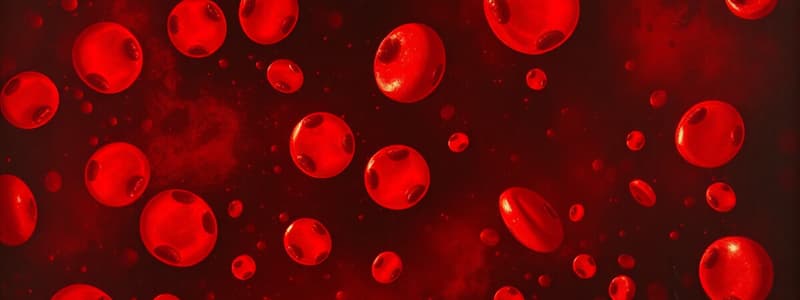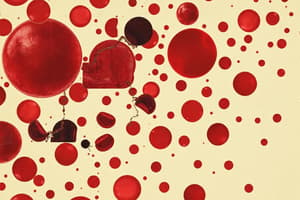Podcast
Questions and Answers
If a patient's blood work indicates a high white blood cell count, what condition might a doctor suspect?
If a patient's blood work indicates a high white blood cell count, what condition might a doctor suspect?
- An infection (correct)
- Impaired lung function
- A broken tissue
- A structural damage in bones
The sinoatrial node in the heart is responsible for initiating the heartbeat. If this node malfunctions, which of the following would be directly affected?
The sinoatrial node in the heart is responsible for initiating the heartbeat. If this node malfunctions, which of the following would be directly affected?
- The liver blood filtration
- Muscle contractions in the arms
- Systemic blood circulation (correct)
- The lungs oxygenation
If a patient is experiencing edema (swelling) due to fluid imbalance, which plasma protein might be deficient?
If a patient is experiencing edema (swelling) due to fluid imbalance, which plasma protein might be deficient?
- Globulins
- Albumin (correct)
- Fibrinogen
- Myosin
A patient has a wound that is not clotting properly. Which plasma protein is most likely deficient?
A patient has a wound that is not clotting properly. Which plasma protein is most likely deficient?
How does the unique biconcave shape of erythrocytes (RBCs) enhance their primary function?
How does the unique biconcave shape of erythrocytes (RBCs) enhance their primary function?
If a patient's lab results show a significantly low hematocrit level, which condition is most likely?
If a patient's lab results show a significantly low hematocrit level, which condition is most likely?
In carbon monoxide poisoning, carbon monoxide binds more strongly to hemoglobin than oxygen does; what is the immediate physiological consequence?
In carbon monoxide poisoning, carbon monoxide binds more strongly to hemoglobin than oxygen does; what is the immediate physiological consequence?
Erythropoietin (EPO) is released in response to hypoxia, and the main effect of EPO is to:
Erythropoietin (EPO) is released in response to hypoxia, and the main effect of EPO is to:
Someone with polycythemia is at risk for:
Someone with polycythemia is at risk for:
In sickle cell anemia, the altered shape of red blood cells leads to:
In sickle cell anemia, the altered shape of red blood cells leads to:
What is the primary role of neutrophils during an infection?
What is the primary role of neutrophils during an infection?
In an allergic reaction, basophils release histamine, leading to what immediate effect?
In an allergic reaction, basophils release histamine, leading to what immediate effect?
What is the role of lymphocytes in the immune response?
What is the role of lymphocytes in the immune response?
What is the role of monocytes?
What is the role of monocytes?
During hemostasis, what is the immediate response to blood vessel injury?
During hemostasis, what is the immediate response to blood vessel injury?
In leukemia, the cancerous cells primarily affect:
In leukemia, the cancerous cells primarily affect:
What is the main function of red bone marrow in adults?
What is the main function of red bone marrow in adults?
The hemocytoblast stem cell is responsible for:
The hemocytoblast stem cell is responsible for:
A person with type O blood has which of the following antibodies in their plasma?
A person with type O blood has which of the following antibodies in their plasma?
An Rh-negative mother is pregnant with an Rh-positive fetus. What immunological concern arises during the pregnancy or delivery?
An Rh-negative mother is pregnant with an Rh-positive fetus. What immunological concern arises during the pregnancy or delivery?
Flashcards
What type of tissue is blood?
What type of tissue is blood?
A type of connective tissue
What are blood tests used for?
What are blood tests used for?
Identifying infections, diseases, and nutrient levels.
Initiating blood circulation
Initiating blood circulation
The heart
Major blood components?
Major blood components?
Signup and view all the flashcards
What is the buffy coat composed of?
What is the buffy coat composed of?
Signup and view all the flashcards
Function of albumin in plasma
Function of albumin in plasma
Signup and view all the flashcards
Plasma protein for immunity
Plasma protein for immunity
Signup and view all the flashcards
Fibrinogen's importance
Fibrinogen's importance
Signup and view all the flashcards
Shape of erythrocytes (RBCs)
Shape of erythrocytes (RBCs)
Signup and view all the flashcards
What do RBCs lack?
What do RBCs lack?
Signup and view all the flashcards
What is hematocrit?
What is hematocrit?
Signup and view all the flashcards
Hemoglobin's role
Hemoglobin's role
Signup and view all the flashcards
Hemoglobin composition
Hemoglobin composition
Signup and view all the flashcards
Oxygen molecules per hemoglobin?
Oxygen molecules per hemoglobin?
Signup and view all the flashcards
What is erythropoiesis?
What is erythropoiesis?
Signup and view all the flashcards
Hormone for erythropoiesis
Hormone for erythropoiesis
Signup and view all the flashcards
Stimulus for erythropoietin
Stimulus for erythropoietin
Signup and view all the flashcards
Erythrocyte's end of life
Erythrocyte's end of life
Signup and view all the flashcards
What is polycythemia?
What is polycythemia?
Signup and view all the flashcards
Definition of anemia?
Definition of anemia?
Signup and view all the flashcards
Study Notes
Blood Composition and Function
- Blood is classified as a connective tissue.
- Blood tests aid in identifying infections, diseases, and nutrient levels.
- The heart is responsible for initiating blood circulation.
- Major blood components: plasma, erythrocytes (red blood cells), leukocytes (white blood cells), and platelets.
- The buffy coat consists of leukocytes and platelets.
Plasma and Proteins
- Albumin in plasma regulates osmotic pressure.
- Globulins are plasma proteins that assist in immunity.
- Fibrinogen is essential for blood clotting.
Erythrocytes and Hemoglobin
- Erythrocytes (RBCs) are biconcave discs.
- RBCs lack a nucleus and mitochondria.
- Hematocrit refers to the percentage of RBCs in blood.
- Hemoglobin transports oxygen.
- Hemoglobin comprises 4 globin chains and 4 heme groups.
- One hemoglobin molecule can carry four oxygen molecules.
RBC Life Cycle and Disorders
- Erythropoiesis is the production of red blood cells.
- Erythropoietin (EPO) regulates erythropoiesis.
- Low blood oxygen stimulates erythropoietin production.
- At the end of their lifespan, erythrocytes are broken down in the spleen/liver.
- Polycythemia refers to an excess of RBCs.
- Anemia is characterized by a lack of hemoglobin or RBCs.
- Sickle cell disease causes crescent-shaped RBCs that carry less oxygen.
Leukocytes and Platelets
- Leukocytes are also known as white blood cells.
- Monocytes are not granulocytes.
- Neutrophils digest bacteria.
- Eosinophils fight parasitic infections and allergens.
- Basophils release histamine in allergic reactions.
- Lymphocytes attack infected cells or make antibodies.
- Monocytes become macrophages and phagocytize pathogens.
- B cells and T cells are types of lymphocytes.
- B cells make antibodies.
- T cells attack infected or cancerous cells.
- Leukocyte abundance order: Neutrophils, lymphocytes, monocytes, eosinophils, basophils ("Never Let Monkeys Eat Bananas").
- Integrins and selectins are adhesion molecules that help with white blood cell emigration.
Platelets and Hemostasis
- Platelets are cell fragments involved in clotting.
- Hemostasis is the process that stops bleeding.
- Mechanisms of hemostasis: vascular spasm, platelet plug, and coagulation.
Hematopoiesis and Blood Typing
- Leukemia is cancer of white blood cells (WBCs).
- Thrombocytopenia is characterized by a low platelet count.
- Hematopoiesis is the formation of blood cells.
- Red marrow makes blood cells.
- Yellow marrow stores fat.
- All blood cells arise from hemocytoblasts (hematopoietic stem cells).
- B cells and T cells come from lymphoid stem cells.
- All blood cells, except lymphocytes, come from myeloid stem cells.
Blood Types
- Type A blood has A antigens and anti-B antibodies.
- Type B blood has B antigens and anti-A antibodies.
- Type AB blood has A and B antigens, but no antibodies.
- Type O blood has no antigens, but both anti-A and anti-B antibodies.
- Type AB blood is the universal recipient (no Rh considered).
- Type O blood is the universal donor (no Rh considered).
- Rh+ blood has the Rh antigen.
- Rh- blood lacks the Rh antigen.
- Type A- blood has the A antigen only.
- Type A+ blood has both A and Rh antigens.
- An Rh- mother carrying an Rh+ baby will produce Rh antibodies that can attack future Rh+ babies.
Studying That Suits You
Use AI to generate personalized quizzes and flashcards to suit your learning preferences.




